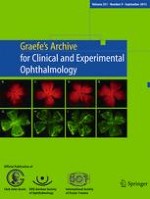Erschienen in:

01.08.2005 | Clinical Investigation
Relationship of eye burns with calcifications of the cornea?
verfasst von:
Norbert Franz Schrage, Sirpa Kompa, Bettina Ballmann, Martin Reim, Stephanie Langefeld
Erschienen in:
Graefe's Archive for Clinical and Experimental Ophthalmology
|
Ausgabe 8/2005
Einloggen, um Zugang zu erhalten
Abstract
Introduction
The clinical pattern of corneal calcification has been considered to be a part of chronic eye diseases, such as uveitis, severe glaucoma, keratitis and eye burns. Since, in some cases of eye burns, we have found corneal calcifications to be related to the initial calciferous caustic agents and to the use of phosphate-buffer-containing fluids, we have reviewed our files of clinical eye burns for the incidence and appearance of corneal calcification.
Methods
A total of 176 burnt eyes of 98 patients suffering from severe eye burns were retrospectively reviewed. The following data set was acquired: the type of caustic agent, the time of the burns, the delay and type of immediate treatment and the time and type of first aid, the subsequent medication, the clinical grading and the later results.
Results
Calciferous burning agents and corneal calcification are correlated (P<0.01). Initial single rinsing with phosphate does not produce corneal calcification (P=0.134). There is evidence that corneal calcifications are correlated with chronically administered phosphate-buffered eye drops (P<0.005).
Discussion
Eye burns followed by calcifications follow two different major patterns: the corrosive substance contained calcium or the continued therapy was applied with phosphate-buffered eye drops. We present case reports of three different types of eye burns and later therapy resulting in corneal calcification. Corneal calcifications are presumably related to longer-lasting phosphate application. One suspicious mechanism is the low content of calcium ion stabilizing proteins such as hyaluronate or fetuin in treatments for severe eye burns. The exceeding of the solubility product of Ca2+ and PO4− results in the precipitation of calcium phosphates. In cases of chronic corneal disturbance, we recommend the elimination of phosphate-buffered medications to prevent corneal calcification.